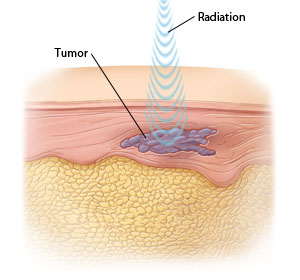Stereotactic Body Radiotherapy (SBRT) for Cancer
Stereotactic body radiotherapy (SBRT) is a form of external beam radiation therapy used to treat cancer. It is also known as stereotactic ablative radiotherapy (SABR). For this treatment, radiation is very precisely aimed at the tumor. High doses of radiation and fewer treatments are used compared to regular radiation therapy.
Your healthcare provider may advise SBRT if the tumor is small and well-defined on imaging scans. It might also be used if your cancer can't be treated with surgery or other methods. SBRT may be used to help cure or control the growth of cancer. Or it might be used to help reduce pain and other symptoms caused by cancer.
This sheet tells you more about SBRT and what to expect. If you have questions about this treatment, talk with your provider.
How SBRT works
SBRT uses strong focused X-ray beams that target a well-defined tumor. Imaging studies are used to get very clear pictures of the tumor. Then a machine called a linear accelerator (LINAC) sends high doses of X-rays into the tumor. This can help kill cancer cells or slow their growth. It can also shrink the tumor. Each radiation dose is precisely aimed. So it reduces damage to the normal tissue and organs near the tumor. This also helps reduce the risk of side effects.

Getting ready for treatment
SBRT is given by a radiation therapy team. This team often includes the following providers:
-
Radiation oncologist
-
Nurse
-
Radiation therapist
-
Physicist
-
Dosimetrist
Before treatment starts, you’ll have 1 or more visits with your team to plan and get ready for your treatment. This is called simulation. This may include having other tests and imaging scans done. Before your first treatment:
-
You may need to have fiducial markers (called seeds) put in or near the tumor. The markers are tiny pieces of gold metal. They show up clearly on imaging studies. They are used to help guide your radiation treatment. Your provider will explain this to you in more detail if markers are needed. They aren't removed after treatment. And they don't cause you harm.
-
You may have scans or other imaging tests done. These are used to map out exactly where the radiation needs to go to treat the tumor. This helps limit damage to the tissues around it.
-
Body molds, masks, rests, and cushions might be made. These are used to keep you from moving. They help hold your body in the same position for each treatment.
Having SBRT treatments
With SBRT, 1 to 5 treatments are given over 1 or 2 weeks. You and your team will talk about your treatment schedule in advance. Each treatment session takes about 60 to 90 minutes. Here’s what to expect during each session:
-
You change into a patient gown. The radiation therapist helps you get into position on the treatment table. If positioning devices were made, they're used at this time.
-
The therapist leaves the room and turns on the machine from outside. They watch you on a screen. You and the therapist can speak through an intercom.
-
X-ray or CT scans are used to make sure that the beams from the machine are lined up correctly. The beams are then aimed at the tumor. You will hear the machine and it may move. But you won’t feel anything.
-
You can go home shortly after the treatment is done. You're not radioactive and can be around people.
Possible side effects of SBRT
With any form of radiation therapy, healthy cells and tissue around the tumor can also be affected by the treatment. This can lead to side effects. These can include severe tiredness (fatigue) and skin changes. Most side effects go away over time after treatment ends. But some side effects may not happen until months or even years after treatment.
The type of side effects and how bad they are will vary. It depends on the amount of radiation you get and the part of your body being treated. Your healthcare provider can tell you more about what side effects to expect and how to manage them. If needed, your provider may give you medicines to treat some side effects. Your healthcare team can also teach you ways to help cope with and help prevent side effects.
When to call your healthcare provider
Make sure you know what number to call if you have problems outside of office hours. This includes evenings, weekends, and holidays. Call your healthcare provider if you have any of these:
-
Fever of 100.4 ºF ( 38 ºC) or higher, or as advised by your provider
-
Extreme tiredness that doesn’t get better between treatments
-
Pain that doesn’t go away, especially if it’s in the same place
-
A new or abnormal lump, bump, or swelling
-
Feeling dizzy or lightheaded
-
Abnormal rashes, bruises, or bleeding
-
Uncontrolled nausea and vomiting
-
Diarrhea that doesn’t get better over time
-
Skin breakdown or severe pain due to skin irritation
-
Any new or concerning symptom
Call 911
Call 911 right away if you have:
Follow-up
After SBRT, you’ll have follow-up visits with your healthcare provider. These let your provider see how you're feeling, talk about side effects, and check on the progress of your treatment. If more tests or treatments are needed, your provider will discuss these with you.